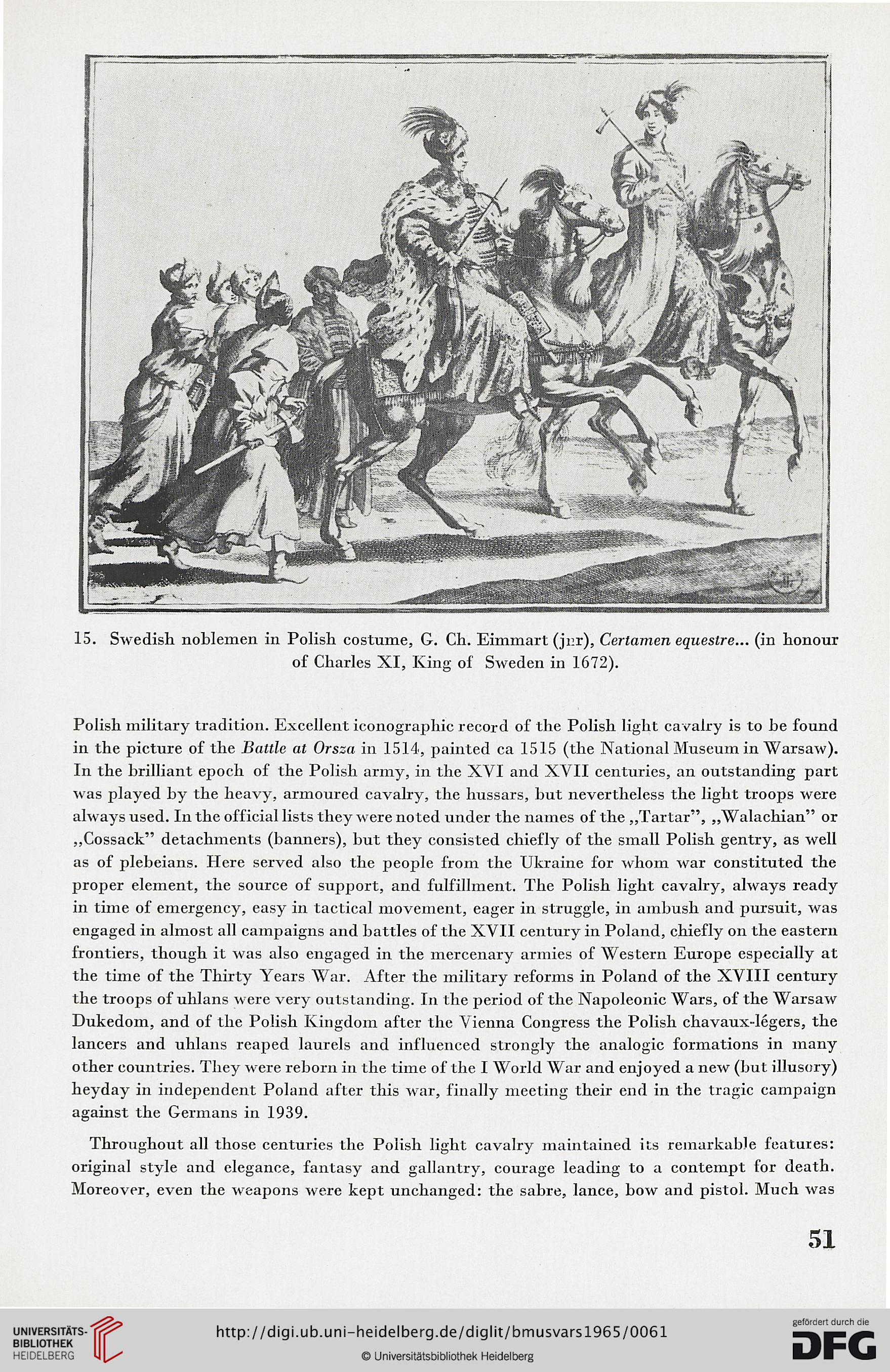15. Swedish noblemen in Polish costume, G. Ch. EimmarŁ (jer), Cerlamen eąuestre... (in honour
of Charles XI, King of Sweden in 1672).
Polish military tradition. Excellent iconographic record of the Polish light cavalry is to be found
in the picture of the Battlc at Orsza in 1514, painted ca 1515 (the National Museum in Warsaw).
In the brilliant epoch of the Polish army, in the XVI and XVII centuries, an outstanding part
was played by the heavy, armoured cavalry, the hussars, but nevertheless the light troops were
always used. In the official lists they were no ted under the names of the „Tartar", „Walachian" or
„Cossack" detachments (banners), but they consisted chiefly of the smali Polish gentry, as well
as of plebeians. Here served also the people from the Ukrainę for whom war constituted the
proper element, the source of support, and fulfillment. The Polish light cavalry, always ready
in time of emergency, easy in tactical movement, eager in struggle, in ambush and pursuit, was
engaged in almost all campaigns and hattles of the XVII century in Poland, chiefly on the eastern
frontiers, though it was also engaged in the mercenary armies of Western Europę especially at
the time of the Thirty Years War. After the military reforms in Poland of the XVIII century
the troops of uhlans were very outstanding. In the period of the Napoleonie Wars, of the Warsaw
Dukedom, and of the Polish Kingdom after the Vienna Congress the Polish chavaux-legers, the
lancers and uhlans rcaped laurels and influenced strongly the analogie formations in many
other eountries. They were reborn in the time of the I World War and enjoyed a new (bul. illusory)
heyday in independent Poland after this war, finally meeting their end in the tragic campaign
against the Germans in 1939.
Throughout all those centuries the Polish light cayalry maintained its remarkable features:
original style and elegance, fantasy and gallantry, courage leading to a contempt for death.
Moreoyer, even the weapons were kept unehanged: the sabre, lance, bow and pistol. Much was
51
of Charles XI, King of Sweden in 1672).
Polish military tradition. Excellent iconographic record of the Polish light cavalry is to be found
in the picture of the Battlc at Orsza in 1514, painted ca 1515 (the National Museum in Warsaw).
In the brilliant epoch of the Polish army, in the XVI and XVII centuries, an outstanding part
was played by the heavy, armoured cavalry, the hussars, but nevertheless the light troops were
always used. In the official lists they were no ted under the names of the „Tartar", „Walachian" or
„Cossack" detachments (banners), but they consisted chiefly of the smali Polish gentry, as well
as of plebeians. Here served also the people from the Ukrainę for whom war constituted the
proper element, the source of support, and fulfillment. The Polish light cavalry, always ready
in time of emergency, easy in tactical movement, eager in struggle, in ambush and pursuit, was
engaged in almost all campaigns and hattles of the XVII century in Poland, chiefly on the eastern
frontiers, though it was also engaged in the mercenary armies of Western Europę especially at
the time of the Thirty Years War. After the military reforms in Poland of the XVIII century
the troops of uhlans were very outstanding. In the period of the Napoleonie Wars, of the Warsaw
Dukedom, and of the Polish Kingdom after the Vienna Congress the Polish chavaux-legers, the
lancers and uhlans rcaped laurels and influenced strongly the analogie formations in many
other eountries. They were reborn in the time of the I World War and enjoyed a new (bul. illusory)
heyday in independent Poland after this war, finally meeting their end in the tragic campaign
against the Germans in 1939.
Throughout all those centuries the Polish light cayalry maintained its remarkable features:
original style and elegance, fantasy and gallantry, courage leading to a contempt for death.
Moreoyer, even the weapons were kept unehanged: the sabre, lance, bow and pistol. Much was
51




